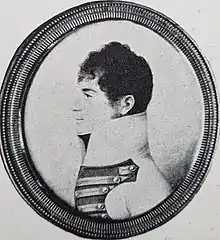Anders Gustaf von Düben
Anders Gustaf von Düben (Swedish pronunciation: [ˈânːdɛʂ ˈɡɵ̂sːtav fɔn dy:ʹbən]; 2 June 1785 – 4 October 1846) was a Swedish painter and military officer. Notably, he maintained personal connections with the former royal house of Holstein-Gottorp, which historically held the throne of the Kingdom of Sweden. Düben gained recognition for being the final Swedish individual, along with Johan Fredrik Ernst von Vegesack, to receive an exile sentence, owing to his implication in the Düben-Vegesack treason incident.
Anders Gustaf von Düben | |
|---|---|
 Portrait by Jakob Axel Gillberg | |
| Born | 2 June 1785 Stockholm, Sweden |
| Died | 4 October 1846 (aged 61) Stockholm, Sweden |
| Buried | 10 October 1846 Hedvig Eleonora Church |
| Wars and battles | Franco-Swedish War |
| Noble family | Düben family |
| Spouse(s) | Carolina Maria, Baroness von Düben (m. 1810; died 1846) (née Eckhardt) |
| Issue | Viktor Cesar |
| Father | Henrik Jakob von Düben |
| Mother | Julie af Petersens |
Early life
Born in Stockholm, Sweden, into the Düben family, renowned for its contributions to classical music, he held the title of Freiherr. He entered the world as the son of the diplomat Henrik Jakob von Düben and Julie af Petersens,[1] who's dad was Herman Petersen. His ancestry comprised a blend of French, Dutch, German, and Scottish origins, with a lineage tracing back to French Huguenots in Saintonge.
Military career
At the age of eighteen, Düben was appointed as fänrik in the Svea Life Guards. He later served as a lieutenant during the Franco-Swedish War, earning the military medal For Valour in the Field (Swedish: För tapperhet i fält) in 1807. Subsequently, he assumed the rank of captain in the army and was bestowed with the title and dignity of major in 1815.[1] Following his military career, he then pursued a vocation as a painter and exhibited at the Royal Swedish Academy of Fine Arts' exhibition in 1826.
Düben-Vegesack-treason
Düben was the last Swedish person sentenced to exile, along with Johan Fredrik Ernst von Vegesack, due to their ties to the late Hereditary Prince of Sweden,[2] as they were suspected of having kept an illegal correspondence with the Prince.[3] Even though Düben had pledged in 1829 to stop corresponding with him.[4] Düben's ties to Gustav, Prince of Vasa was established during the Prince's infant years. He was a supporter of the Prince's family and their lineage.[5]
Vegesack, who at the time was stationed in Berlin, sent a letter to his friend von Düben, asking him to meet up with Gustav, Prince of Wasa, during a sejour to Vienna in the winter of 1832. Vegsack had denied that the letter was written by him.[6] The letter was intercepted, leading to von Düben and von Vegesack being accused of treacherous acts.[2][7] Which consequently led to the arrest of Veseack and Düben on the Charge of High Treason on October 4, 1832.[8] In March 1833, they received an exile sentence,[9] and in May, they both went to Germany.[10] He returned to Sweden in 1835.
Family
In 1810, he got married to a woman from Swedish Pomerania named Carolina Maria Eckhardt (1794–1861). She was the daughter of a printer named Johann Heinrich Eckhardt.[11] They had a child named Cesar von Düben, who later became a pioneer in photography.[12]
Appointments
References
- Hofberg et al. 1906, p. 259.
- Hultman 1974, p. 166.
- Bloomfield 1884, p. 285.
- Bloomfield 1884, p. 286.
- Bloomfield 1884, p. 288.
- Bloomfield 1884, p. 287.
- Hildebrand 1945, p. 634.
- Lindeberg 1839, p. 271.
- Ridderstad 1882, p. 167.
- Lindeberg 1839, p. 277.
- Anrep 1858, p. 635.
- Bennett, Stewart & Payne 2009, p. 20.
Sources
- Anrep, Gabriel (1858). Svenska adelns ättar-taflor utgifna: Abrahamsson-Graufelt (in Swedish). P. A. Norstedt & Son̈er.
- Bennett, Terry; Stewart, Lindsey; Payne, Anthony (2009), History of Photography in China 1842–1860, ISBN 9780956301208 – via Google Books
- Bloomfield, Benjamin (1884). Memoir of Benjamin, Lord Bloomfield. Cornell University Library. London, Chapman and Hall – via Google Books.
- Hildebrand, Bengt (1945). "Düben, Düben von, släkt" (in Swedish). National Archives of Sweden. p. 634.
- Hofberg, Herman; Heurlin, Frithiof; Millqvist, Viktor; Rubenson, Olof (1906). 8. Düben, Anders Gustaf von (in Swedish). Retrieved 13 April 2021 – via Project Runeberg.
- Hultman, Harald (1974). Prinsen av Vasa: den siste gustavianen (in Swedish). Bonnier. ISBN 978-91-0-039377-9.
- Lindeberg, Anders (1839). Bidrag till Sveriges Historia efter den 5 November 1810. [By A. Lindeberg.] (in Swedish).
- Ridderstad, Carl Fredrik (1882). Regnbågen: Interiörer från olika tider Anteckningar och minnen (in Swedish). Ridderstad – via Google Books.
External links
 Media related to Anders Gustaf von Düben at Wikimedia Commons
Media related to Anders Gustaf von Düben at Wikimedia Commons